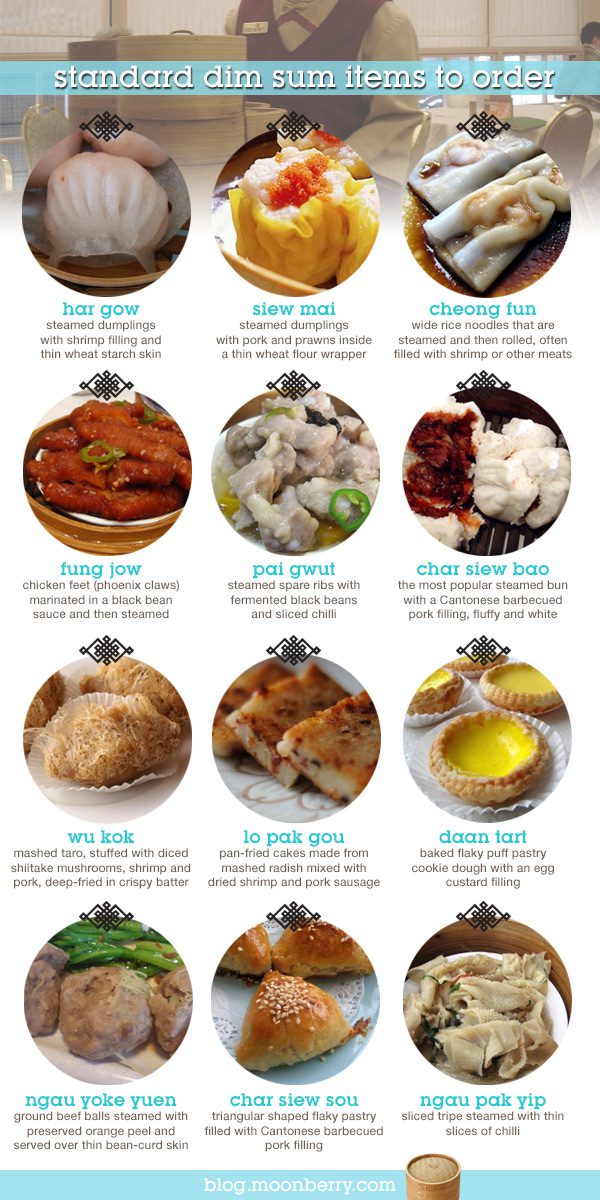

Many Cantonese restaurants serve dim sum as early as five in the morning, while more traditional restaurants typically serve dim sum until mid-afternoon. The tea is very important, just as important as the food.

ĭim sum restaurants typically have a wide variety of dishes, usually totaling several dozen. Some estimates claim that there are at least two thousand types of dim sum in total across China, though only about forty to fifty types are commonly sold outside of China. But that is not the case with Cantonese dim sum, which has developed into a separate branch of cuisine. In fact, the cookbooks of most Chinese food cultures tend to lump their own variations on the dim sum theme with other local snacks. There are over one thousand dim sum dishes originating from Guangdong province alone, a total that no other area in China comes even close to matching. Cantonese dim sum has a very broad range of flavors, textures, cooking styles and ingredients, and can be classified into regular items, seasonal offerings, weekly specials, banquet dishes, holiday dishes, house signature dishes, travel-friendly, as well as breakfast or lunch foods and late night snacks. As dim sum continued to develop, chefs introduced influences and traditions from other regions of China. Cantonese dim sum was based originally on local foods. Cantonese dim sum culture developed rapidly during the latter half of the nineteenth century in Guangzhou. The practice of having tea with dim sum eventually evolved into the modern yum cha (brunch). Teahouse owners gradually added various snacks called "dim sum" to their offerings. The second is dim sum ( 點心) and translates literally to "touching heart", the term used to designate the small food items that accompanied the tea drinking.

This refers to the custom of serving teahouse customers two pieces of delicately made food items, savory or sweet, to complement their tea. The first is " yat jung leung gin" ( 一盅兩件), which translates literally as "one cup, two pieces". In the tenth century, when the city of Guangzhou (Canton) began to experience an increase in commercial travel, many frequented teahouses for small-portion meals with tea called yum cha, or "drink tea" meals. Most modern dim sum dishes are commonly associated with Cantonese cuisine, although dim sum dishes also exist in other Chinese cuisines. Image courtesy of New World Makati Hotel.Dim sum ( traditional Chinese: 點心 simplified Chinese: 点心 pinyin: diǎnxīn Cantonese Yale: dím sām) is a large range of small Chinese dishes that are traditionally enjoyed in restaurants for brunch. For special occasions and functions, Jasmine also has four cozy private dining rooms to make your day extra special.Īlso read: Jasmine in Makati: A True Cantonese Tradition at New World Hotel

Located at the second level, Jasmine is open daily for lunch and dinner offering your favorite Chinese dishes. This offer is especially good now that the Chinese New Year is coming up-everyone will surely flock to Jasmine, so better book your table now! For reservations, please call 0 or book it directly here. Meanwhile, the weekend offer costs Php1,388, which includes a choice of main and beverage. Get it for as low as Php988 per person, which is served with soup, rice or noodle dish and dessert on weekdays. Indulge in a real Chinese lunch with unlimited dim sum until April 30, 2019. In fact, this mouthful steamed light meal is enough to make us drool the moment we see it being served in our favorite restaurant.Įxcitingly, you can chow down on your favorite dim sum as many as your tummy wants with an unlimited offer from Jasmine at New World Makati Hotel. With many Chinese restaurants cropping up in the country, the classic dim sum has become a quite accessible dish for many foodies out there.


 0 kommentar(er)
0 kommentar(er)
